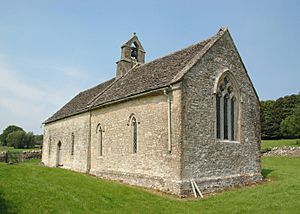Widford, Oxfordshire facts for kids
Quick facts for kids Widford |
|
|---|---|
 St. Oswald's parish church |
|
| OS grid reference | SP2712 |
| Civil parish |
|
| District |
|
| Shire county | |
| Region | |
| Country | England |
| Sovereign state | United Kingdom |
| Post town | Burford |
| Postcode district | OX18 |
| Dialling code | 01993 |
| Police | Thames Valley |
| Fire | Oxfordshire |
| Ambulance | South Central |
| EU Parliament | South East England |
| UK Parliament |
|
Widford is a special place in Oxfordshire, England. It's known as a deserted medieval village, which means it was once a busy village in the Middle Ages but is mostly empty now. Widford is located near the River Windrush, about 1.5 miles east of a town called Burford. For a long time, it was a separate piece of Gloucestershire county, even though it was surrounded by Oxfordshire, until 1844.
Contents
Exploring Widford's Past
Widford has a very long history, going back thousands of years!
Ancient Roman Life in Widford
Long ago, during the time of the Roman Empire, people lived here. We know this because parts of a Roman villa (a large Roman house) have been found. The local church, St. Oswald's Church, was actually built right where this Roman villa used to be. Inside the church, there was even a small piece of Roman mosaic (a picture made from tiny colored tiles). This mosaic has since been moved to a museum in Cirencester to keep it safe.
Widford in the Middle Ages
The Domesday Book, a famous record from 1086, shows that a place called St Oswald's Priory in Gloucester owned the land of Widford. This is why Widford was considered part of Gloucestershire for many centuries, even though it was geographically separate from the rest of that county.
The church you see today, St. Oswald's, was built in the 13th century. It's an example of Early English Gothic style. In the 14th century, artists added beautiful wall paintings inside the church. You can still see parts of these old paintings today! Most of the church's windows were updated later, in the 16th and 17th centuries.
Why Did Widford Become Deserted?
Widford was a lively village during the Middle Ages. However, over time, most people moved away. Today, only a few buildings remain, including a manor house from the 16th century. If you look closely at the field where St. Oswald's Church stands, you can see faint lines on the ground called cropmarks. These marks show where the foundations of old buildings used to be, revealing the outlines of the former village.
Changes to Widford's County
In 1844, a law called the Counties (Detached Parts) Act officially moved Widford from Gloucestershire to Oxfordshire. It became its own small civil parish (a local administrative area) in 1866. But by 1931, very few people lived there – only 29! So, on April 1, 1932, Widford's civil parish joined with the nearby parish of Swinbrook to form the new "Swinbrook and Widford" parish. A small part of Widford also became part of Shilton.
Notable People Connected to Widford
A famous historian and priest named Vivian H. H. Green is buried in the churchyard of St. Oswald's. He was once the head of Lincoln College, Oxford, a well-known university college.
Images for kids



